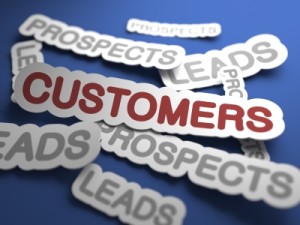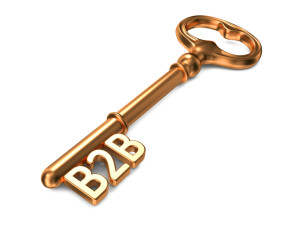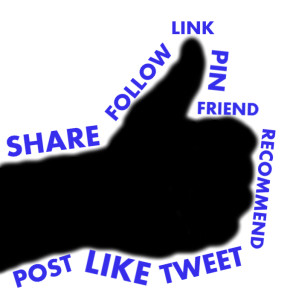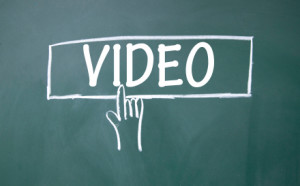by gabriel_sales | Feb 21, 2014
 Marketers obviously have good intentions with their content marketing strategy, but what they produce often ends up missing the mark.
Marketers obviously have good intentions with their content marketing strategy, but what they produce often ends up missing the mark.
For example, you may only care about the business benefits of a solution, but the content you are sent is a high level technical overview. Or, you are just trying to quickly learn the basics about something, and the only content offered is a 20-page white paper.
Experiences like this can be frustrating for the B2B buyer. To them, it seems that there is a disconnect between their needs and your solution. In this day and age, if buyers can’t find the answers they want with relative ease, they are moving on to your competitor.
To solve this problem, here are three steps to creating highly engaging B2B content that converts:
1. Build buyer persona/personas for each type of buyer you sell to.
The first step is taking the time to truly understand your buyer. In B2B sales, this often means understanding the multiple types of buyers that are now involved in the sales process. Each of these buyers may have different needs and concerns, and you need to understand these concerns completely before creating any content. For example, while the CEO may care most about P&L, the HR rep and the IT manager have entirely different concerns.
2. Map out your sales cycle into stages, and create content to match.
With your buyer personas in mind, the next step is mapping out your buying cycle. To keep things simple, break it up into three stages: education, verification and closing. Then, create content for each stage for each of your buyer personas. Ask yourself, if I were an IT manager and knew nothing about X product/service, what would I need to see to feel educated on the basics? Ask yourself the same for the CEO, the marketer or whoever else is involved in the buying process. Then move on to the verification stage, and ask yourself what each type of buyer persona would need to see to verify that you are the best choice among the many alternatives. Again, remember that verification for an executive may look entirely different than verification for someone in marketing. Finally, do the same for closing stage.
3. Use marketing automation to push content at appropriate times.
With your personas and content created, you can use your marketing automation platform to gauge what type of persona each prospect has and where he or she is in their particular buying cycle. By offering each prospect content that speaks to his or her most pressing needs at the appropriate time, your prospects will find your content genuine and valuable and will be much more likely to convert.
By following these steps, your prospects will feel like you understand them, which is the first stage in establishing trust. To learn more about creating quality B2B content, read “5 Reasons Your Content Isn’t Converting”. Please feel free to contact us with any questions.
by gabriel_sales | Feb 13, 2014
 Over the past few years, we have created a lot of different types of videos for our clients. We are finding that one of the most valuable types of videos to use in the B2B sales process is a ‘headshot’ video of an executive.
Over the past few years, we have created a lot of different types of videos for our clients. We are finding that one of the most valuable types of videos to use in the B2B sales process is a ‘headshot’ video of an executive.
These are effective for several reasons. First, they allow prospects to start to get to know the people behind the company. B2B sales is (and has always been) about relationship building and headshot videos help to start this process in a digital format. Second, humans are hardwired to pay attention to faces; apparently, the Fusiform Facial area of the brain causes this. In the midst of thousands of marketing messages coming at your prospects each day, anything that can encourage them to pay more attention is good.
If you have never created a headshot video before, here are 5 basic tips to help you get started:
- Dress professionally. What this means may differ from company to company (i.e. an enterprise software company vs. a hip, new tech startup), but looking the part is always a good place to start. Make sure your clothes, hair, makeup, etc. are in line with your company’s image.
- Address sound quality. For people new to video production, sound can be a hard thing to get right. Start by making sure there is no background noise in the space you are recording. To create a tone of professionalism, make sure your executive has a relatively high-quality microphone.
- Check your lighting. If you do not have a professional video studio with lighting, your best bet is to shoot in a room with a lot of natural light. Whatever you do, stay away from harsh lighting and directional lighting for headshots.
- Add a text bar. For headshot videos, you want it to be immediately clear who is speaking. Always put the name and title of the featured executive in a text bar at the beginning and end of the video.
- Don’t shoot with your iPhone. This goes without saying, but you need to produce high quality videos if you want them to be effective as a sales tool. Your best bet is to shoot in HD. If this is not affordable, try to go for a 16:9 aspect ratio and a resolution of at least 640×360.
If you would like to see an example of an executive headshot video, you can watch this testimonial video from one of our clients. For more on the value of video in B2B sales, read 3 Reasons You Should Leverage B2B Video in 2014.
by gabriel_sales | Feb 12, 2014
 While 93% of B2B companies are now engaged in content marketing, it seems many are still struggling to see their content have a direct impact on sales. An interesting survey from McKinsey suggests the reason for this has to do with the branding or messaging behind the content. The data shows that what companies think makes a good brand and what customers want from a brand are two different things.
While 93% of B2B companies are now engaged in content marketing, it seems many are still struggling to see their content have a direct impact on sales. An interesting survey from McKinsey suggests the reason for this has to do with the branding or messaging behind the content. The data shows that what companies think makes a good brand and what customers want from a brand are two different things.
The survey asked B2B customers what they cared about most when looking to select a company or brand. The three top responses were:
- Cares about honest, open dialogue with its customers and society
- Acts responsibly across its supply chain
- Has a high level of specialist expertise
However, when B2B companies were asked what branding message they were conveying to customers, the top three responses were:
- Role-models corporate social responsibility in its work
- Promotes and practices sustainability in its products or services
- Has global reach
These findings suggest B2B companies are missing an opportunity to connect with customers by talking past them. It seems that B2B companies may be attempting way more than they need to in their branding and marketing content.
Based on these responses, B2B companies seem to think they need to save the world. They seem to think customers want superheroes who can travel the world at lighting speed and solve the world’s environmental problems in their free time.
While customers would probably like that, it is not what they care most about while shopping for a B2B solution. Looking at the top responses, B2B customers simply want to know that you are genuine, responsible and good at what you do.
So, when coming up with your brand story and determining how to best tell that story through digital content, don’t over complicate or attempt to be something more than you are. Just explain what you do and how you do it in an authentic and helpful way.
For more on telling a consistent brand story, read What Confuses Your Prospect Most About Your Sales Process. Feel free to contact us with any questions.
by gabriel_sales | Jan 30, 2014
 Answer: A lack of consistency.
Answer: A lack of consistency.
In today’s fast-paced and technology obsessed world, it has been estimated that people are exposed to 3,000-20,000 marketing messages per day (NYT).
While that estimate seems rather high, it highlights the sheer enormity of marketing content out there—all competing for our attention and clicks. In this chaotic and competitive environment, how do you create content that stands out enough to get your prospects to convert and/or buy?
You create an authentic brand story, and then tell that story consistently across multiple channels.
Telling a consistent brand story does not mean saying the exact same words over and over again in all of your marketing content. It means creating a consistent impression or experience for your prospect every time they interact with your company. Saying the same words multiple times may play a part in that, but there are also many other factors go into creating consistency for your prospects.
Let’s look at an example of an inconsistent brand story experience to illustrate the importance of consistency.
Let’s say George receives a marketing email from a managed service provider. The email has little in the way of color or graphics; the content of the email is educational, and the tone of the writing is serious and professional. George reads the email and decides to click through to the additional content being offered, as he is someone who highly values professionalism in the workplace.
However, when George clicks through to the MSP’s content, he finds a page with neon colored graphics, pushy advertisements and informal language. At first, George is so confused that he wonders if he even clicked on the right link. After confirming the MSP did indeed send him to this flashy, ad-covered web page, George is left even more puzzled.
He wonders which of the two experiences the company actually provides. One story being told insinuates the MSP is an industry thought-leader and approaches their work with a high level of professionalism and seriousness. The other story implies the MSP cares more about aesthetics and has more of a bold, ‘in-your-face’ type of approach to business.
Only one of these stories is appealing to George. But, because he cannot figure out which of the stories is true just by viewing the content, he is going to move on to a competitor who provides him with a less confusing—and more consistent—brand experience.
While George’s story is fictional, the problem of inconsistent marketing and sales content is real and may cause you to miss out on revenue opportunities. To make the brand story your are telling more consistent, pay attention to:
- your tone of voice
- your level of formality
- the colors, graphics and other visuals you use
- your communication frequency
- the connotations of the words you use
- your social media posting style
By providing a more consistent brand experience for your prospects throughout the length of your sales process, they will be much more willing to trust you and therefore eventually, make a purchase.
To learn more about improving your B2B sales process, read “3 Reasons Your B2B Sales is Failing”. Feel free to contact us with any questions.
by gabriel_sales | Jan 24, 2014
 40% of Americans now use Facebook everyday. Whether we are aware of it or not, I think this has had some interesting effects on marketing.
40% of Americans now use Facebook everyday. Whether we are aware of it or not, I think this has had some interesting effects on marketing.
Most of us now scroll through our various social media feeds a couple of times throughout the day, and as we do, we constantly see Youtube videos, memes, Buzzfeed and Upworthy-type content—all competing for likes and shares.
This creates the impression that going viral and getting shares is the ultimate goal to be achieved. And for marketers, it fuels the desire to create marketing content that will make those ‘like’, ‘share’ and ‘retweet’ counts jump into the thousands.
While there is nothing inherently wrong with that approach, marketing content should always have a goal that is tied to business. If your only goal is brand awareness, trying to create viral videos or blog posts is a good strategy—viral content gets seen by more people. However, if your goal is to put prospects into the pipe or close deals, going for viral might not be appropriate.
This is because being viral does not equate directly to having value (i.e. cat videos). Turning the thousands of viewers of your content into prospects and leads generally requires providing some sort of value. What exactly that value is will vary greatly depending on the product or service.
In the B2C space, providing entertainment might be enough value to initiate a purchase. There is a lot less risk purchasing B2C products, which allows more room to be impulsive. In the B2B space however, where purchases are sometimes multimillion dollar enterprise software solutions, content that provides a few laughs is not likely going to be enough to get a contract signed.
In more complex, higher-risk sales, creating content that is valuable should trump your desire for creating content that goes viral. Content that provides value in these complex sales includes opinion’s of thought leaders, industry reports, software demonstrations, product comparisons, case studies, etc. This type of informative and fact-based content enables prospects to educate themselves on your product or solution, so they are able to make an informed purchase decision. While this type of content may not be as exciting or share-worthy as the latest Volvo ad, it does provide the type of value that will build enough trust to motivate a high-risk purchase.
If you would like to know more about creating valuable B2B marketing content, read “5 Reasons Your Content Isn’t Converting.” Feel free to contact us with any questions.
by gabriel_sales | Jan 8, 2014
 If you’re in B2B, it is likely you know by now that ‘content is king’. But, what kind of content is going to be king in 2014? We think it is video.
If you’re in B2B, it is likely you know by now that ‘content is king’. But, what kind of content is going to be king in 2014? We think it is video.
Why? Here are three reasons:
1. It translates to less work for you.
One of the best ways to leverage B2B video marketing is to clone your top producers. By digitizing your early-stage sales pitch into video format, you no longer give that pitch over and over again every time a new prospect comes down the pipe. You can just send each new prospect a link to your pitch video, saving you the many hours you spend pitching to only vaguely qualified prospects.
2. It’s science.
According to Dr. Susan Weinschenk, also known as ‘the brain lady’, there are hardwired biological and psychological phenomenon that make video a more engaging and persuasive format than text. Weinschenk gives four reasons for this:
- The Fusiform Facial area makes us pay attention to faces
- Voice conveys rich information
- Emotions are contagious
- Movement grabs attention
~Watch her detailed presentation on the topic here
When presenting information in video format, the experience your prospect has is multi-dimensional (auditory and visual) and therefore deeper than the experience of a purely auditory (podcast) or purely visual (blog post) format. Because emotional connection plays such a large role in B2B sales, anything you can do to create a deeper or more emotional experience is good.
3. It’s measurable.
The importance of measurement and analytics is growing rapidly in B2B with the advent of marketing automation platforms and sales technologies along with the rise of customer relationship management. Videos are great for measurement and ROI reporting because they are easily trackable. Some video hosting platforms (like Wistia) allow you to not only track views, but also how long prospects are watching each video. In the case that most of your prospects stop watching at the one-minute mark, this will help you know when and how to refine your message.
For tips on leveraging B2B video, you can read our Tips for B2B Video Content Marketing. Feel free to contact us with any questions.
 Marketers obviously have good intentions with their content marketing strategy, but what they produce often ends up missing the mark.
Marketers obviously have good intentions with their content marketing strategy, but what they produce often ends up missing the mark.





